
I think a lot of costumers, especially newbies and those that haven’t sewn from the Romantic Era, start out by thinking the best way to achieve the skirt silhouette is to begin with a hoop skirt. That couldn’t be farther from the authentic truth as the metal cage crinoline/hoopskirt we know of wasn’t invented until 1856. (That’s the first patent year.)
The absolute finest way to accomplish the silhouette of the 1830s and 40s is do what they did – multiple petticoats. But not just layers and layers of plain ones (although they were there too). No, what you need is a petticoat with cords running through it.
Corded petticoats are the structured undergarment of this in-between period from after the Regency through Early Victorian (up to the American Civil War, 1860s). The stiffening of cotton muslin or linen with horsehair (crinoline) and cording helped to hold the petticoat away from the legs for easier movement. Of course, many more layers of petticoats were worn over the corded one to create the fashion of the day.
Let’s take a quick look at just how supportive and fashionable a corded petticoat can be when worn underneath a plain muslin petticoat.
Below is a straight panel cotton petticoat worn over chemise and corset with no corded petticoat. Notice the drape of the single layer of muslin against the legs.
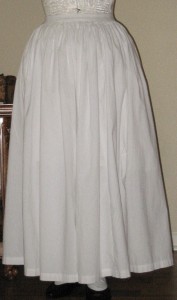
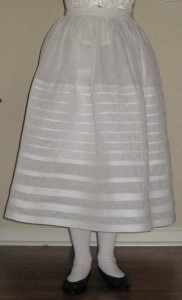
This is an organdy corded petticoat with an 86” hem width. This corded petticoat is not starched. It gets its flare from the stiff organdy fabric and the heavy cording set into sections.
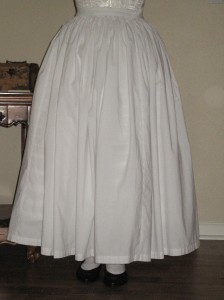
Ta-da! The plain petticoat worn over the corded one. Look at that hem flare!
You can see the width of the over-petticoat is slightly flared at the hem and lies more evenly around over the corded petticoat. Also notice that by not sewing the cords in closer to the waist that only the skirt hem is flared and the silhouette becomes more bell-shaped rather than domed.
Here’s another example.
This is a cotton muslin corded petticoat with an 82” hem width. Notice that the cording goes a lot higher up towards the waist on this one. This corded petticoat is also not starched. It is standing out only by the heavy cotton rope used as cording.
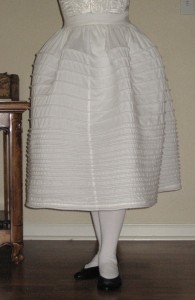
Now take a look at the same plain petticoat worn over this particular corded petticoat. You can see the over-petticoat lies smoothly around the corded one.
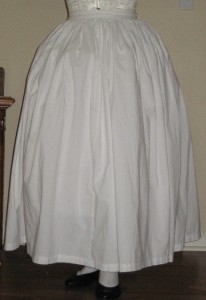
Amazing, huh? What is clearly seen is the effect of the cording being sewn as close to the waistband as possible. This gives a nice 1840s dome shape to the over-petticoat. Add a ton (like 3-5) more petticoats and you’ll get an early 1850s look.
Remember the following tips when you are researching, sewing and wearing your own corded petticoat.
-Corded petticoats DO NOT give you the same silhouette as a hoop skirt
-CPs will not be as strong as a metal-boned hoop skirt
-CPs naturally wave in and out as they circle your body (This is smoothed out with over petticoats and is VERY period accurate.)
-CPs are soft undergarments that sway and fold easily
-The more cords in a CP, the more supportive a garment
-The higher the cording in a CP, the more dome shape you’ll get (perfect for 1830s and 1850s)
-You can starch CPs for added body and support but they will still not be as supportive as a hoopskirt
Have you noticed the difference a corded petticoat makes under your Romantic Era/Early Victorian costumes? What do you like about the look they give to your overall silhouette? Please leave a comment below for discussion.

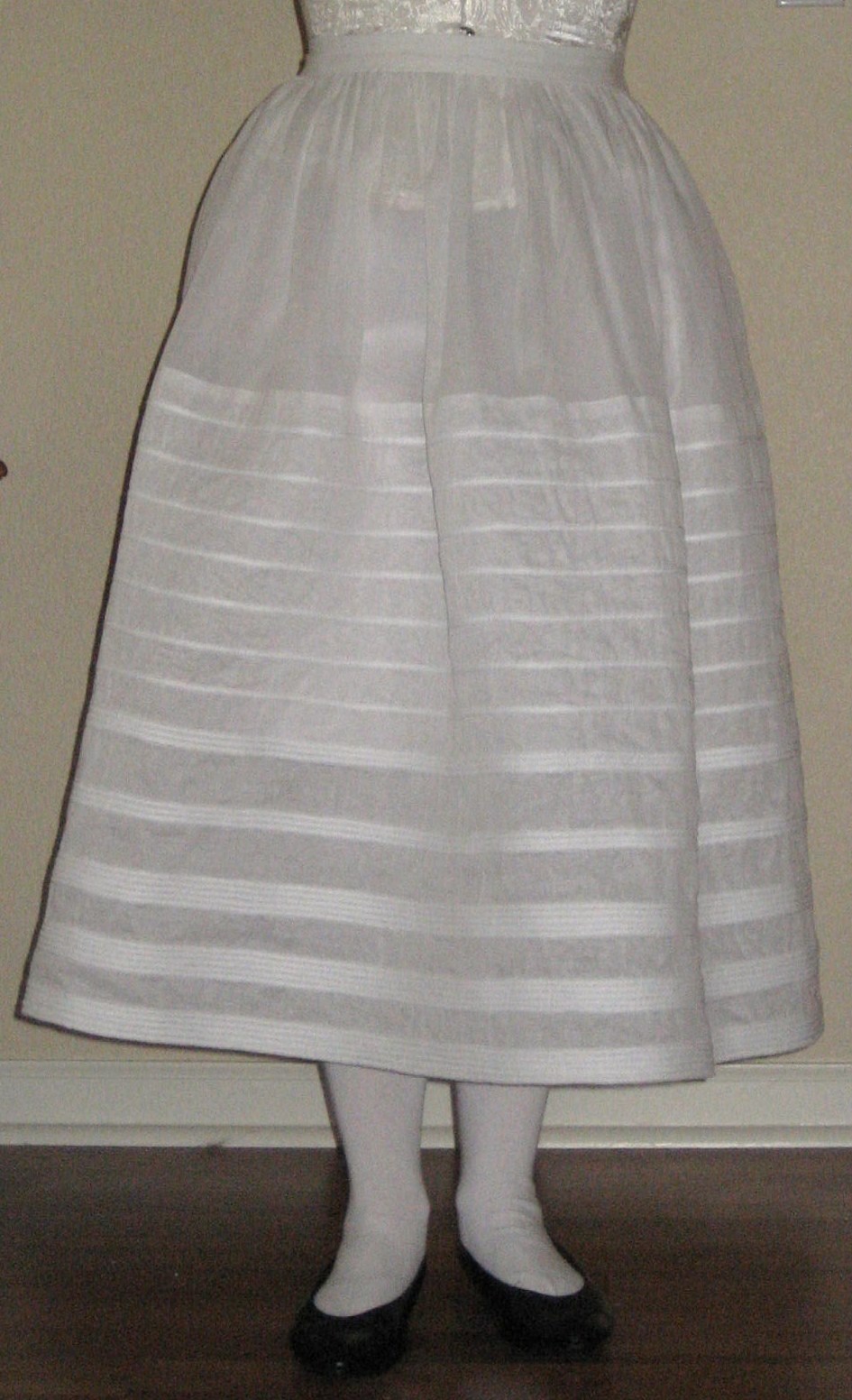
Thank you so much for this! I l have been thinking of doing corded petticoats for a lower class impression for Dickens Faire and this totally helps in the idea and vision of how the skirts sit.
Cheers!
Gina
Yay! So happy to hear you found it helpful. Best of luck with your skirts! 🙂
Ok, now it appears that I will have to make another corded petticoat for an 1840s dress! This time with bigger cording! This is an awesome visual of how the pettis make the skirt look! You rock!
Gina
I’m not sure you need to make another one. Depends on the silhouette you are trying to create. A few petticoats – ruffled, plain, starched, etc.- may be all you need. I’ve made several corded petticoats but wear one most often for both 1830s and 1840s.
Hi Jennifer,
Really lovely to see the different shapes they make. Do you have any info on the correct length of corded petticoats. I have noticed many of them are quite short compared to plain petticoats. Would the plain ones worn over the top be longer than the corded one (prob a stupid question). I’m looking to put together a few basic Victorian undergarments that will cover me for several decades and a good corded petticoat seems to be a must have . The shape they create is so pretty and does give an authentic to a dress look. I tried making the Past Patterns one in cotton but it was a bit of a hash tbh, the cording was to wide. It is wearable though. Would it be worth making a muslin one with fine cording to go over it or would this be to much structure/weight. They are are flippin heavy. I’m worried I might not be able to move!!
Thanks
Katy 😀
Thanks for the interesting and very helpful post, Jennifer. I’m making 1850’s dresses for my 8- and 12-year old daughters as we’re off to Xmas in July at Sovereign Hill (which is a Victorian Gold rush town near where we live in Australia). Hopefully they’ll be finished by Friday!
Best of luck!
Jennifer, Thank you for this post! My next big project is 1838-39 dress, so that means making the underpinnings. I went to a class at CoCo several years ago and learned quite a bit, but having you display the difference by putting a cp under the top petticoat was a real eye opener for me
You are welcome Carolyn! Was that my corded petticoat class at CoCo or Kendra’s fabulous overview class (which I myself learned SO much in)? The best of luck on your underpinnings!
I’m more of an 1860s girl myself, but I have often wondered about the many layers of petticoats bunching up at the waist. How do you minimize the layers? Even with just my hoop and two petticoats under my 1860s dresses, I feel quite padded. Speaking of padding, I’m also quite curious about quilted petticoats. Were they used at all in the ’60s? I have a “work a day” impression that I would like to have correct petticoats underneath.
In my research quilted petticoats were worn for a long time. By the 1860s they were mainly underpetticoats and usually worn only during cold weather seasons. A quilted one with a couple others on top would be fine for a working impression. However, they mainly are for warmth and not support to stand your skirt out, but they’ll hold your upper skirts away from your legs enough.
Take a look at this article for reducing petticoat layers around the waist: https://historicalsewing.com/reducing-petticoat-layers-so-your-waist-looks-small
Thank you!
Dear Mrs. Rosbrugh
First of all, I’m a fan to your work and to your blog. I pass by at least twice a week to check for novelties.
I’m in doubt. I’m starting to sew 1840-43 dress which happens to be…red. I know it’s not the most proper color, but I found this beautiful brocade and I just couldn’t resist. It’s not for a 100% accurate historical reenactment, so I think it’s not a big trouble.
I wasn’t feeling very comfortable about wearing a white petticoat under a red skirt, so I bought red fabric to make a plain and a corded petticoat. Is there any notice of colored petticoats, corded or not, during early Victorian Era?
Best Regards
Pauline Kisner
Pauline, you’ll find quite a number of colored petticoats in the Romantic Era. I’ve seen many blue, green and gold/yellow ones but most are quilted and not plain. From what I’ve researched, plain & ruffled petticoats were made mostly from white or off-white cottons or linen as they could handle the frequent washing and starching. Colored fabrics would be expensive and therefore ignored for undergarment use.
Corded petticoats, both in my research and ones I personally own, are made from natural colored cotton or linen or with a ticking stripe in blue or such.
All that to say, if you want a red petticoat, by all means make it! Just know it wasn’t the norm for the era. By the 1860s you’d see more colored petticoats but white was still the favored color.
After much research and fingernail biting I decided on a CP of cotton and cotton cordage. I was told that a small cord from lower calf to hip would be the perfect thing. It is a great “show and tell” says my friend. Show them what you did and Tell them not to do it. I am sure that when it is completed that is will be just what I want… but at this point I am 108 rounds out of the 130 needed. Haha will it ever be done?
Yay – you’re almost done! You can do it. I think people don’t realize the amount of work that goes into a corded petticoat. “Oh, it’s just straight sewing of the rows of cords.” Yeah – but it takes a LONG time to do.
Best of luck finishing! Please post pictures on the Facebook wall or send in and I’ll post. Cheers!
Fantastic! I’ve seen plenty of corded petticoats before, but this is the first I’ve seen a comparison of two different ones. It’s much easier to see how differing cording amounts/placement change the final look. thanks!